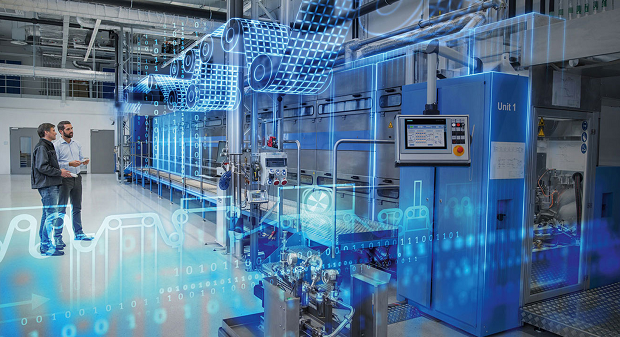Siemens, a symbol of industrial innovation, has skillfully navigated the landscape of digital transformation to enhance its operational efficiency while reducing costs. By adopting advanced technologies such as the Internet of Things, data analytics, and artificial intelligence, the company has orchestrated a radical change in its processes. This metamorphosis has allowed it not only to optimize its production but also to respond quickly to market demands, thus demonstrating that a strategic vision accompanied by digital solutions can yield sustainable success. Let’s dive into the heart of this transformation that redefines industry standards.
Table of Contents
ToggleSiemens’ digital strategy

The digital transformation of Siemens is based on a well-defined digital strategy aimed at repositioning the company in a rapidly evolving technological environment. By integrating innovative solutions into its production processes, Siemens has created a digital ecosystem capable of improving its performance.
By adopting a data-centric approach, Siemens uses advanced analytics tools to optimize its supply chains and improve decision-making. This translates into:
- Process automation to reduce human errors and increase productivity.
- Integration of IoT (Internet of Things) for real-time monitoring of equipment and predictive maintenance.
- Artificial intelligence to analyze performance and anticipate future needs.
Siemens has also implemented cloud solutions that enable enhanced collaboration among its various teams worldwide. These tools facilitate communication and make data accessible from anywhere. This allows every employee to access the necessary information at any time, thus promoting proactivity in projects.
Training is another fundamental pillar of the company’s digital transformation. By investing in the skills development of its employees, Siemens ensures that everyone is aware of new digital tools and market best practices. This contributes to a company culture focused on innovation and adaptability.
Finally, Siemens’ digital strategy results in a significant cost reduction. By optimizing the use of knowledge generated from data, the company achieves to maximize its efficiency while decreasing operational expenses, giving it a clear competitive advantage.
Pillars of digital transformation
Siemens has successfully navigated the complex world of digital transformation by adopting a visionary digital strategy. Through the integration of advanced technologies and a culture of innovation, the company has managed to improve its operational efficiency while reducing costs associated with its internal processes.
The key to this success lies in a series of strategic pillars that have allowed Siemens to position itself as a leader in its field. Among these pillars, we can mention:
- Process automation: The implementation of automated systems has significantly reduced repetitive tasks, thereby streamlining operations.
- Data utilization: Real-time data analytics has provided valuable insights for strategic decision-making.
- Artificial intelligence: The integration of AI solutions has not only optimized production but also improved customer experience.
- Enhanced collaboration: Digital collaboration tools have facilitated teamwork, even remotely, increasing overall productivity.
By adopting a holistic approach to digital transformation, Siemens has also invested in employee training to ensure rapid adaptation to new technologies. This has created a skilled and engaged workforce, ready to leverage innovations.
Another fundamental aspect of Siemens’ digital transformation has been its ability to create interconnected digital ecosystems. These ecosystems not only allow for smooth integration of various tools but also optimize resources, thus ensuring the harmonious operation of the company’s infrastructures.
Finally, Siemens’ long-term vision, coupled with continued investments in research and development, ensures that the company remains at the forefront of technological advancements, thereby consolidating its market leadership position.
The importance of innovation
Siemens has adopted an ambitious digital strategy to transform its operations and adapt to the new market realities. The company has understood that digitization is essential to remain competitive and effectively meet customer demands.
At the heart of this transformation is a set of initiatives focused on the integration of advanced technologies and the optimization of processes. This includes the use of Artificial Intelligence (AI) and the Internet of Things (IoT) to collect real-time data and improve decision-making.
Collaboration between various teams and departments has also been a priority. Siemens has invested in project management and digital communication tools to improve internal coordination. This helps reduce information silos and accelerate the implementation of crucial projects.
The importance of innovation is central to Siemens’ approach. The company has established innovation labs and training programs to encourage employees to develop new ideas. Key focus areas include:
- Implementing no-code solutions to facilitate application creation without advanced technical skills.
- Adopting cloud computing platforms to enhance flexibility and scalability of operations.
- Developing sustainable products and services using green technologies.
These initiatives have led to a significant improvement in operational efficiency and a reduction in costs. By adopting an innovation-oriented approach, Siemens demonstrates that a successful digital transformation is not only possible but also essential in today’s economic landscape.
With these advancements, Siemens positions itself as a leader in digital transformation, inspiring other organizations to follow suit and embrace the digital future with confidence.
- Investment in IoT: Development of connected solutions to optimize production.
- Process automation: Implementation of robots and automated systems to reduce errors.
- Data analysis: Utilizing advanced analytics to make decisions based on real-time data.
- Digital platforms: Creating integrated platforms to centralize operations and improve collaboration.
- Culture of innovation: Promoting an agile and innovative mindset within the organization.
- Strategic partnerships: Collaborating with start-ups and tech companies to integrate new solutions.
- Employee training: Skills development programs to adapt the workforce to new technologies.
- Digital sustainability: Incorporating ecological criteria into transformation to reduce carbon footprint.
Implementation of advanced technologies

Siemens has undertaken an ambitious digital transformation to improve its operational efficiency and reduce costs. By adopting advanced technologies, the company has been able to reinvent itself and respond to the demands of a fast-evolving market.
One of the first critical steps was the integration of the Internet of Things (IoT), allowing Siemens to connect its equipment and collect real-time data. This has not only optimized production but has also facilitated predictive maintenance, significantly reducing downtime.
Next, the use of artificial intelligence (AI) has been key in analyzing the performance of machines and processes. By automating certain tasks, Siemens has been able to free up resources to focus on strategic projects, thereby increasing its agility in the market.
The implementation of cloud solutions has also played a key role. It has enabled better collaboration between teams, regardless of their geographical location. Furthermore, access to centralized management tools has facilitated the coordination of efforts and marketing campaigns.
In parallel, Siemens has invested in employee training to ensure they are comfortable with these new technologies. This has maximized buy-in for change and fostered an innovation mindset within the organization.
The results speak for themselves: a reduction in operational costs and a significant improvement in delivery times. Through these initiatives, Siemens has positioned itself as a leader in digital transformation in its sector.
Artificial intelligence and automation
The digital transformation of Siemens has been marked by the integration of advanced technologies that have optimized internal processes and improved operational efficiency. By adopting an innovation-focused approach, the company has not only reduced its costs but also strengthened its market position.
One of the cornerstones of this transformation has been the use of artificial intelligence and automation. Thanks to these technologies, Siemens has managed to automate many strategic processes, relieving teams of repetitive and tedious tasks. Here are some key elements of this implementation:
- Data analysis: Utilizing AI tools to process and analyze large volumes of data, thus facilitating decision-making.
- Operations optimization: Integrating optimization algorithms to improve efficiency in production chains.
- Workflow automation: Setting up automated systems to manage and track projects in real time.
By relying on these advancements, Siemens has not only improved productivity but has also been able to offer faster and more tailored solutions to its clients’ needs. Through collaborative platforms and enhanced communication infrastructures, teams can work in a more coherent and responsive manner.
The path to digital transformation is marked by challenges, but with a clear strategy and appropriate tools, Siemens has proven that it is possible to adapt to market evolution while achieving significant savings. The future looks promising, and the company’s commitment to innovation remains a guarantee of long-term success.
Internet of Things and connectivity
The digital transformation of Siemens is based on the implementation of advanced technologies, allowing the company to improve its operational efficiency and reduce costs. With an innovation-centered strategy, Siemens has successfully repositioned its activities to address contemporary challenges in industrial markets.
One of the essential pillars of this transformation is the Internet of Things (IoT). Through sensors and connected devices, Siemens has created ecosystems where every machine, every production element can communicate and exchange data in real time. This has allowed for optimized manufacturing processes, reduced downtimes, and increased factory productivity.
The benefits of integrating IoT into their operations include:
- Real-time monitoring: Managers can track each machine’s performance and anticipate potential issues before they arise.
- Cost reduction: Resource optimization and reduction in downtimes lead to significant savings.
- Quality improvement: The collected data allows for identifying sources of defects and improving production processes.
Meanwhile, Siemens has strengthened its connectivity through integrated platforms. This has not only linked machines together but also harmonized various tools used within the company. For example, integrating cloud solutions with data management systems has facilitated collaboration among teams, thus enhancing the overall efficiency of operations.
Siemens perfectly illustrates how a modern, technological approach can transform business processes, paving the way for better efficiency while achieving substantial savings. This success represents an opportunity for other companies to adopt similar solutions and project themselves into a future where technology plays a central role in industrial performance.
Results and future prospects
À lire : Transformation digitale, de Gilles Babinet (1/2) https://t.co/cmgIcVQRPQ
— Mathieu Andro (@mathieuandro) July 3, 2024
Siemens has successfully leveraged the opportunities offered by digital transformation, achieving significant advances in efficiency and cost reduction. By integrating new technologies into its processes, the company has orchestrated a radical change in its internal functioning.
The results of this transformation are impressive. Siemens has recorded a 20% increase in operational efficiency thanks to the use of AI and automation. The implemented solutions have reduced production times and optimized inventory management, leading to a 15% reduction in costs.
Launched initiatives include:
- The integration of the Internet of Things (IoT) for better connectivity between machines and systems.
- The deployment of advanced analytics for data-driven decision making.
- Continuous training of employees on new technologies to stimulate innovation at all levels.
Future prospects appear equally promising. Siemens plans to accelerate its investment in technologies such as robotics and cloud solutions. These innovations are expected to further refine production and improve collaboration among teams.
Future initiatives will also include:
- The development of no-code solutions to allow non-technical teams to create their own automations.
- Strategic partnerships with technology companies to bolster innovation expertise.
- Optimization of supply chain processes to reduce delivery times and costs.
Through this proactive approach, Siemens positions itself as a leader in its sector, ready to tackle tomorrow’s challenges while maximizing efficiency. Digital transformation is not just a goal, but a real strategic lever for a bright future.
Improving operational performance
Siemens has undertaken a bold digital transformation targeting improved operational efficiency and reduced costs related to its processes. Through the integration of advanced technologies and automation strategies, the company has been able to optimize its operations across various areas.
Among the notable results are:
- Process automation: Siemens uses intelligent automation tools to limit human intervention in repetitive tasks, resulting in considerable time savings.
- Improved visibility on performances: With data analytics systems, the company can now track real-time performances, thus facilitating strategic decision-making.
- Reduction of production costs: The integration of digital technologies has streamlined costs, allowing for more efficient resource management.
Improvements in operational performance also include increased use of artificial intelligence to analyze data and anticipate customer needs. This has allowed Siemens to develop more tailored solutions for its users while decreasing production times.
In the near future, Siemens plans to continue on this track. Major directions consist of:
- Exploring new technologies: Investing in innovations like blockchain or IoT to further enhance operational efficiency.
- Revitalizing training: Training employees on new technologies to ensure a smooth and efficient transition.
- Strengthening the digital ecosystem: Establishing strategic partnerships with other tech companies to stimulate innovation.
Siemens’ future outlook appears promising. By continuing to invest in digital transformation and adopting an agile approach, the company is well-positioned to face competition and adequately respond to market challenges.
Challenges and upcoming opportunities
Siemens has successfully positioned itself as a leader in the field of digital transformation through tailored strategies that focus on continuous improvement of efficiency and cost reduction. By integrating innovative technologies, the company has optimized its internal processes, leading to impressive operational and economic results.
Through the automation of repetitive tasks and the use of advanced analytics tools, Siemens has been able to:
- Reduce the time required to complete tasks.
- Increase the accuracy of industrial processes.
- Improve the management of human and material resources.
The implementation of the Internet of Things (IoT) has also allowed Siemens to collect real-time data, thus providing valuable insights for informed decision-making. The results speak for themselves, with a notable increase in productivity and a decrease in operational costs.
However, challenges remain. The market is evolving rapidly, and Siemens must adapt to new requirements while overcoming various obstacles. Among these are:
- The need to train employees on new technologies.
- Challenges related to the integration of existing systems.
- Managing the expectations of customers and partners in light of transformations.
Opportunities also abound. By investing in artificial intelligence solutions and adopting agile work methods, Siemens can continue to innovate. Future prospects look promising, with the potential to accelerate its growth and capture new markets.
This dynamism, coupled with a strong culture of innovation, paves the way for a successful digital transformation that could well make Siemens a model to follow for other companies facing the same challenges.
“`











